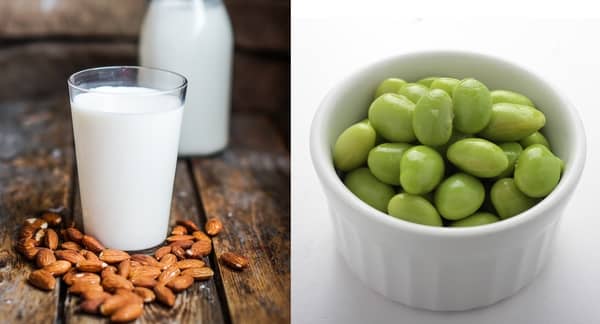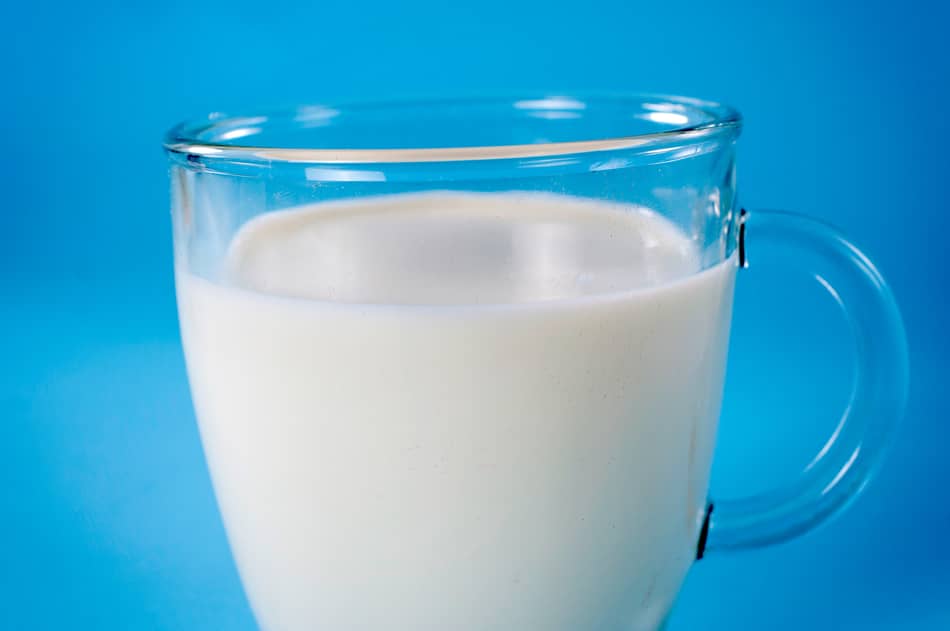Skim milk aka skimmed milk (British English), is the popular low-calorie version of milk, that’s consumed as a beverage, added to recipes, and incorporated as an additive into processed food products.
Many people rely on low-cal food products for health and weight management reasons, so I often get asked by vegans if skim milk is suitable for 100% plant-based eaters.
Is it vegan? No, skim milk is never considered vegan. Unlike plant “milks”, skim milk is an actual dairy product, and thus derived from animals. It’s simply whole milk from cows that’s undergone a process to have the milkfat removed.1
Is it vegetarian? Yes, skim milk is considered vegetarian. To be precise, it’s considered suitable for lacto (or lacto-ovo) vegetarians, the subgroup of vegetarianism that allows for dairy products. But, LV and LVO vegetarianism is pretty much synonymous with vegetarianism in general.
So, what we’ll do here is go over the reasons why skim milk is non-vegan, and then go over the best vegan-friendly alternative to milk.
Why Skim Milk Is Non-Vegan
Veganism Is More than a Health Movement
I think one reason I get asked about skim milk, is due to the assumption—often by those who are new to the subject of plant-based diets—that veganism is mostly a health movement.
And that’s completely understandable. There are enough vegans in the community who are primarily concerned with health to warrant such an assumption.
And if it were true (that veganism is about health), I could see how one might assume that skim milk would be on the menu, given that it’s fat-free and low in calories and cholesterol.
Vegetarianism is the practice of abstaining from the use of animal products, including the consumption of meat (red meat, poultry, and seafood), as well as any by-products of animals that have been processed for food and other purposes.2,3
Veganism, on the other hand, restricts dairy, eggs, and their derivatives (additives, etc.) Veganism is considered the strictest form of vegetarianism for a reason, as it rejects the commodity status of animals for any purpose.4-6
While there are distinctions to be made between various categories of veganism, all categories involve avoiding the consumption of animal products.
For example, dietary vegans, aka strict vegetarians, refrain from consuming all animal products, including meat and eggs and other animal-derived substances.
Ethical vegans, on the other hand, avoid consuming animal products but extend the philosophy into other areas by avoiding the use of animal products in clothing and other items.
I.e. a dietary vegan may not have any misgivings when it comes to wearing leather, fur, etc.
Then, there’s environmental veganism, which avoids animal products because the industrial farming of animals is damaging to the environment and ultimately unsustainable.7
But whatever the reason, the one thing they all have in common is the avoidance of consuming animal products. Full stop.
Dairy Isn’t Exactly a Health Food Anyway
But, even for vegans who are not moved by the ethics of plant-based diets, most go vegan because they believe that milk is uniquely unhealthy due to the presence of more than just saturated fat and cholesterol—after all, coconut and palm oils have saturated fat.
An example might be animal proteins which are thought to potentially be carcinogenic. If you’re interested, it has to do with the animal protein-IGF-1 connection.8-10
It’s also not a very nutrient-dense beverage on its own and requires fortification of vitamins A and D for this reason.11
Because vitamins D and A are fat-soluble, they’re found fairly abundantly in whole milk, which is why whole milk doesn’t require either to be added—though, manufacturers tend to add both vitamins anyway (for good measure, I suppose).12
However, when whole milk is processed into skim milk, the vitamin A and D content is diminished significantly. This goes for 2% reduced-fat, evaporated skim milk, and even dried whole milk.12
While, fortification of whole milk with vitamin D is optional, fortification of skim milk and evaporated whole milk is mandatory.12
Don’t Some Vegans Drink Milk?
Most folks who ask this question are probably thinking of lacto-vegetarians. To be clear, there is no such thing as a lacto-vegan.
A lacto-vegetarian diet aka lactarian diet (a less common term) is a diet that embraces plant foods per usual but allows dairy products like milk, yogurt, cheese, ghee, butter, cream, and kefir.
It’s a very common form of vegetarianism, and in certain regions of the world such as India, the term lacto-vegetarian is pretty much synonymous with the term vegetarian.
The vegetarian consumption of eggs and dairy being so common coupled with the rising awareness of vegan diets (defined by not eating eggs and dairy) have led to lacto-, ovo-, and lacto-ovo vegetarianism becoming synonymous with vegetarianism in general.13
Tangentially, an ovo-vegetarian diet is still considered a form of vegetarianism in most regions. But in India, ovo-vegetarianism is thought by some to be a non-vegetarian diet—lacto-vegetarianism has a unique history in India.14
Skim Milk in Otherwise Vegan Foods
Aside from being consumed as a beverage, skim milk is a common food additive. Unfortunately, a lot of otherwise “accidentally vegan” food products are rendered off-limits for this reason.
I bring this up so that, in addition to avoiding skim milk as a beverage, you’ll know to be on the lookout for skim milk as an ingredient in processed foods.
Margarine
In the past, standard stick margarine contained at least 80% fat, and about 16% water, with the remaining 4% being milk solids.
Due to the widespread ban of trans fat, soft margarines are on the rise, and they contain mostly non-hydrogenated oil, water, and an emulsifier.
Standard ingredients for softer margarines include:15
- Cultured skim milk
- Emulsifiers such as lecithin, mono- and diglycerides
- Preservatives such as sodium benzoate, isopropyl citrate, calcium disodium EDTA, and citric acid, potassium sorbate
- Vitamins A and D
- Flavorings—usually diacetyl and short-chain fatty acids
- Food colorings, such as annatto and/or carotene
Milk additives aren’t always present, but it’s something to look out for.
Processed Foods (General)
Low-Fat Foods
Fat content is the main determinant of how food products turn out. If it’s low-fat, then you can tell immediately, because fat improves both flavor and mouthfeel. It provides a nice smooth texture.
Some of the more common ingredients in reduced-fat foods include skim milk, emulsifiers, stabilizers, and fat substitutes (vegetable gums, etc.).
These ingredients provide body and a smooth texture.16
Imitation Cheese
That’s right, just because a cheese product isn’t actual cheese, doesn’t mean it’s completely non-dairy and suitable for vegans.
Imitation cheese manufacturers make heavy use of caseins—the major protein found in milk and the main component of real cheese.
They either extract the proteins from skim milk via enzyme precipitation or acidification or the skim milk is added to the product directly.17,18
Those are just two examples. But, you get the idea.
Best Vegan Alternatives to Skim Milk

Skim milk tends to contain about 0.1% fat.19
So, any good vegan replacement would also be low in fat and provide a thin (i.e. mostly water) medium—especially, as a substitute in recipes.
It would also need to have a pleasant or at least neutral taste. Thankfully, plant milks meet most of the above criteria.
Soymilk tends to be a bit higher in fat compared to almond milk, but both are great substitutes. Given the higher fat content, soymilk also has a bit more calories.
However, some of those calories are due to the higher protein content.
So, almond milk is lower in calories but lacks protein. So, they both have their strengths and both make great replacements overall. It’s just a matter of preference.
Also, there are several types of plant milk (coconut, flax, oat, etc.), but that should give you an idea of the types of things to consider.
That’s it for the vegan status of skim milk. Thanks for reading.
You may also want to check out the following related articles:
References
- CFR – Code Of Federal Regulations Title 21. https://www.accessdata.fda.gov/scripts/cdrh/cfdocs/cfcfr/CFRSearch.cfm?fr=133.189
- What Is a Vegetarian: The Vegetarian Society. https://www.vegsoc.org/page.aspx?pid=508
- Why Avoid Hidden Animal Ingredients? https://navs-online.org/articles/why-avoid-hidden-animal-ingredients/
- Helena Pedersen, Vasile Staescu, “Conclusion: Future Directions for Critical Animal Studies”, in Nik Taylor, Richard Twine (eds.), The Rise of Critical Animal Studies: From the Margins to the Centre, Routledge, 2014 (262–276).
- Gary Steiner, Animals and the Limits of Postmodernism, Columbia University Press, 2013, 206
- Gary Francione, “Animal Welfare, Happy Meat and Veganism as the Moral Baseline”, in David M. Kaplan, The Philosophy of Food, University of California Press, 2012 (169–189) 182.
- Sea Shepherd’s Paul Watson: ‘You Don’t Watch Whales Die and Hold Signs and Do Nothing’ part Michael Shapiro for Earth Island Journal – https://www.theguardian.com/environment/2010/sep/21/sea-shepherd-paul-watson-whales
- Hubbard, R.W., Mejia, M.S., and Horning, M.C. The potential of diet to alter disease processes. Nutr. Res., 14, 12, 1853, 1994.
- Walter, P. Effects of vegetarian diets on aging and longevity. Nutr. Rev., 55, S61, 1990. https://www.ncbi.nlm.nih.gov/pubmed/9155227
- Key, T.J.A., Thorogood, M., Appleby, P.N., and Burr, M.I. Dietary habits and mortality in 11,000 vegetarians and health conscious people: results of a 17- year follow up. BMJ, 313, 775, 1996. https://www.ncbi.nlm.nih.gov/pubmed/8842068
- How Is Skim Milk Made? Christine Gallary – https://www.thekitchn.com/how-is-skim-milk-made-ingredient-intelligence-215893
- Understanding Food: Principles and Preparation (Page 213). Amy Brown – Wadsworth Cengage Learning – 2011
- Becoming a Vegetarian. Harvard Health Publishing – https://www.health.harvard.edu/staying-healthy/becoming-a-vegetarian
- Spencer, Colin: The Heretic’s Feast. A History of Vegetarianism, London: Fourth Estate 1993, p. 69–84. ISBN 1-85702-078-2.
- Understanding Food: Principles and Preparation (Page 461). Amy Brown – Wadsworth Cengage Learning – 2011
- Understanding Food: Principles and Preparation (Page 540). Amy Brown – Wadsworth Cengage Learning – 2011
- Understanding Food: Principles and Preparation (Page 211). Amy Brown – Wadsworth Cengage Learning – 2011
- Nabisco Easy Cheese American Pasteurized Cheese Snack, 8 Oz. Edward – https://www.walmart.com/ip/Nabisco-Easy-Cheese-American-Pasteurized-Cheese-Snack-8-Oz/10292086
- Ward, Andrew (23 May 2017). No Milk Today – The vanishing world of the milkman (1 ed.). London: Robinson. ISBN 1472138902.

